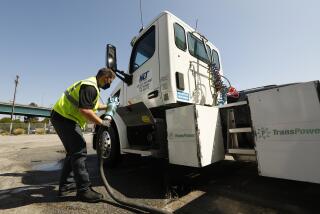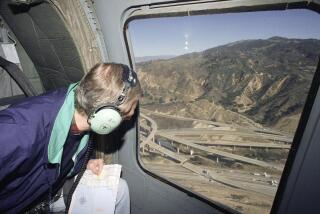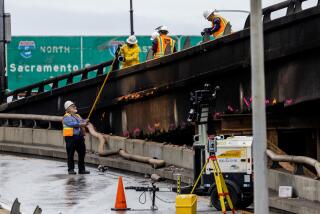China’s roads paved with woes
- Share via
CHONGQING, CHINA — China has been throwing down pavement and asphalt at a breakneck speed, and few cities are as proud of all the new roads as Chongqing, China’s largest metropolis with 32 million people.
More than 6,300 miles of streets, highways and tunnels have been built in this hilly western Chinese city in the last decade -- enough to get from Los Angeles to Juneau, Alaska, and back. The improvements are testament to the impressive infrastructure supporting the nation’s booming economy.
But as fast as construction workers build the roads, the concrete and asphalt is being destroyed -- carved up by a chronic assault from overloaded trucks. The result is 24-hour construction zones and trouble for the environment, the economy and the people living near the highways and byways.
Along a one-mile stretch of a Yangtze River estuary here, construction workers come for weeks at a time, over and over, repaving the same road that is damaged by 60- to 120-ton trucks brimming with coal, cement and other materials.
Residents of Tianming village say they are subjected to constant dust, pounding noise and traffic jams. Recently, a 70-year-old woman was hit by a truck and sent to a hospital.
“It’s no use complaining,” said Zhou Dingjie, 34, a farmer who has lived in this otherwise scenic area all his life. This has been going on for five years, he said. “The government knows the trucks are overloaded, but they want to keep the economy developing. And the trucks want to make more profit.”
The vast majority of trucks on Chinese roads carry loads exceeding regulations, transportation experts say. Some trucking companies admit they are violating rules but say everybody is doing it. Among the reasons: cutthroat competition, surging fuel prices and expensive highway tolls, some of which are imposed illegally by local governments.
The government has set up more monitoring stations on expressways and increased patrols. But “officials haven’t taken full resolve to eradicate this problem,” said Liu Binglian, director of the Traffic Economic Institute at Nankai University in Tianjin. The government’s focus has been limited to certain regions, he said, and traffic bureaus can’t assess penalties exceeding about $140 -- not enough to deter scofflaws.
“China’s road system, which the government invested so much money into, is breaking down fast,” Liu said. “Chinese roads last only one-fifth or even one-eighth of a normal lifespan.”
That leads to wasted resources. China uses about half the world’s cement (the main ingredient in concrete) and consumes vast amounts of metal to reinforce roads and bridges. Chongqing alone has built about 800 bridges in the last decade, including 28 super-large ones, many crossing the Yangtze and Jialing rivers.
Xia Qingfen, a veteran staffer at the Chongqing Traffic Bureau’s maintenance section, said the bureau didn’t have statistics on damaged roads. But “there are just so many such roads, countless. . . . Many break down so often that we have to do small repairs as often as every month.”
Xia added that 10 years ago, roads didn’t need frequent attention. “There are just too many big, heavy trucks now.”
Analysts have estimated that overloaded trucks cause direct economic losses of almost $4 billion a year, but that doesn’t measure damage to the environment, lost time on traffic-congested streets and the accidents caused by or made worse by overloaded trucks.
On a foggy day last April just outside of Chongqing, about 50 cars were involved in a pileup that resulted in five deaths and 36 injuries. Authorities blamed the accident largely on overloaded trucks going too fast. A 2004 report by a research arm of the Ministry of Communications said trucks exceeding weight and height regulations caused about 150,000 accidents a year, resulting in as many as 130,000 fatalities and injuries.
Liu Long, owner of Yu Long Transportation in Anhui province west of Shanghai, says he knows overloading is fraught with danger.
“In the beginning, I strictly obeyed the load limits,” said Liu, who operates 10 trucks that typically transport construction materials and other commodities. “But I found myself losing money. . . . Everything is more expensive: oil, salary for drivers,” he said. “What can I do? I cannot lift my price. I have to follow everyone else.”
Lately, Liu said, he has noticed more police examining load limits, which vary from no more than 20 tons for a two-axle truck to a maximum of 55 tons for vehicles with six or more axles. Liu’s response to the stepped-up patrols: “Now I let my trucks drive more at night to avoid police.”
On a recent early morning, workers were posted on the road leading to Tianming village. A long line of trucks and cars waited as construction crews allowed oncoming vehicles to pass. One driver, a 30-year-old man who gave only his last name, Shen, said he frequently took this route to work and encountered frustration.
“It’s just a few kilometers, but because of the traffic jam, I have to spend an hour more on the road,” he complained. “If you can believe it, this road is undergoing such repair at least two to three times a year.”
Farmers who cultivate picturesque terraced fields by the river were gathered at a small market nearby. They said they had become inured to whirring generators, choking fumes from idling trucks and the constant presence of migrant laborers hauling stones and mixing concrete.
One construction worker, Pan Fuyou, 49, said crews work round the clock. He makes about 60 cents an hour. This was his first time on this site, he said, but joked that he would be back after this repair wrapped up at the end of this month.
“No matter how many times they fix it, it doesn’t really matter,” he said. “It will break down again.”
--
More to Read
Sign up for Essential California
The most important California stories and recommendations in your inbox every morning.
You may occasionally receive promotional content from the Los Angeles Times.











